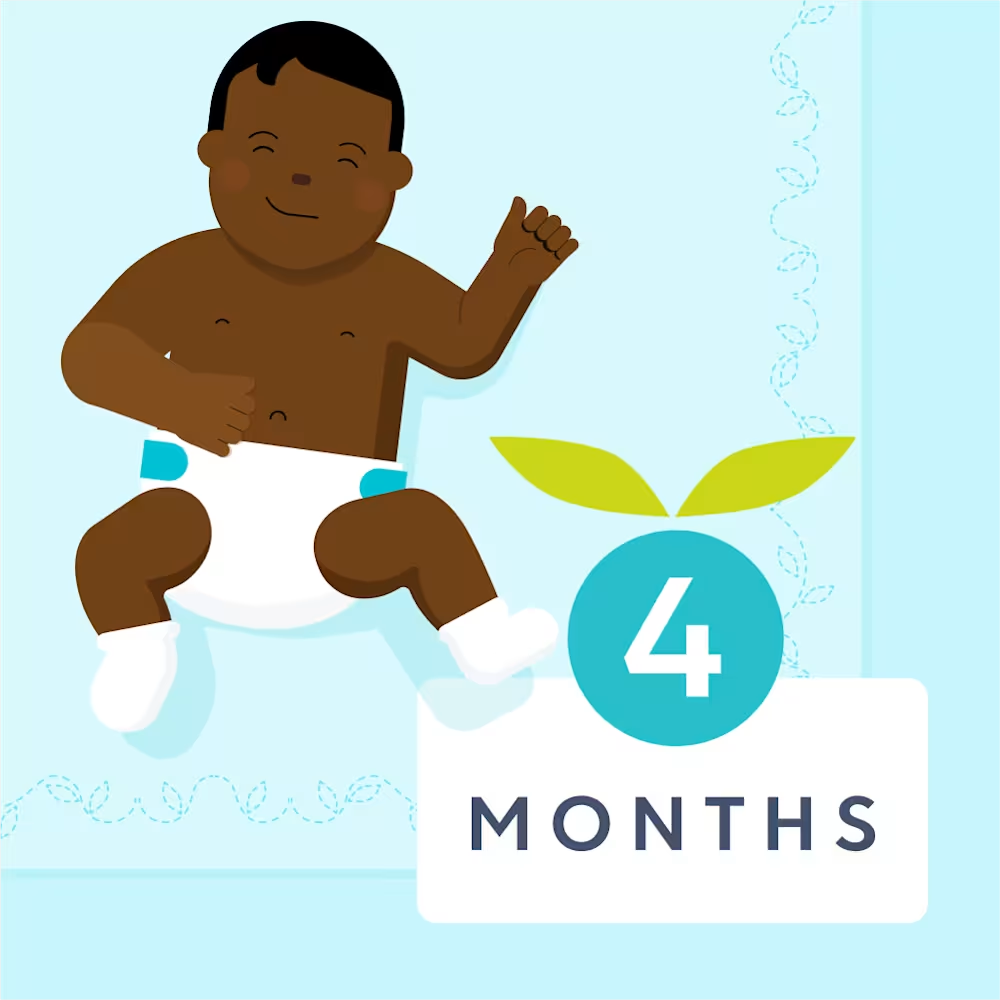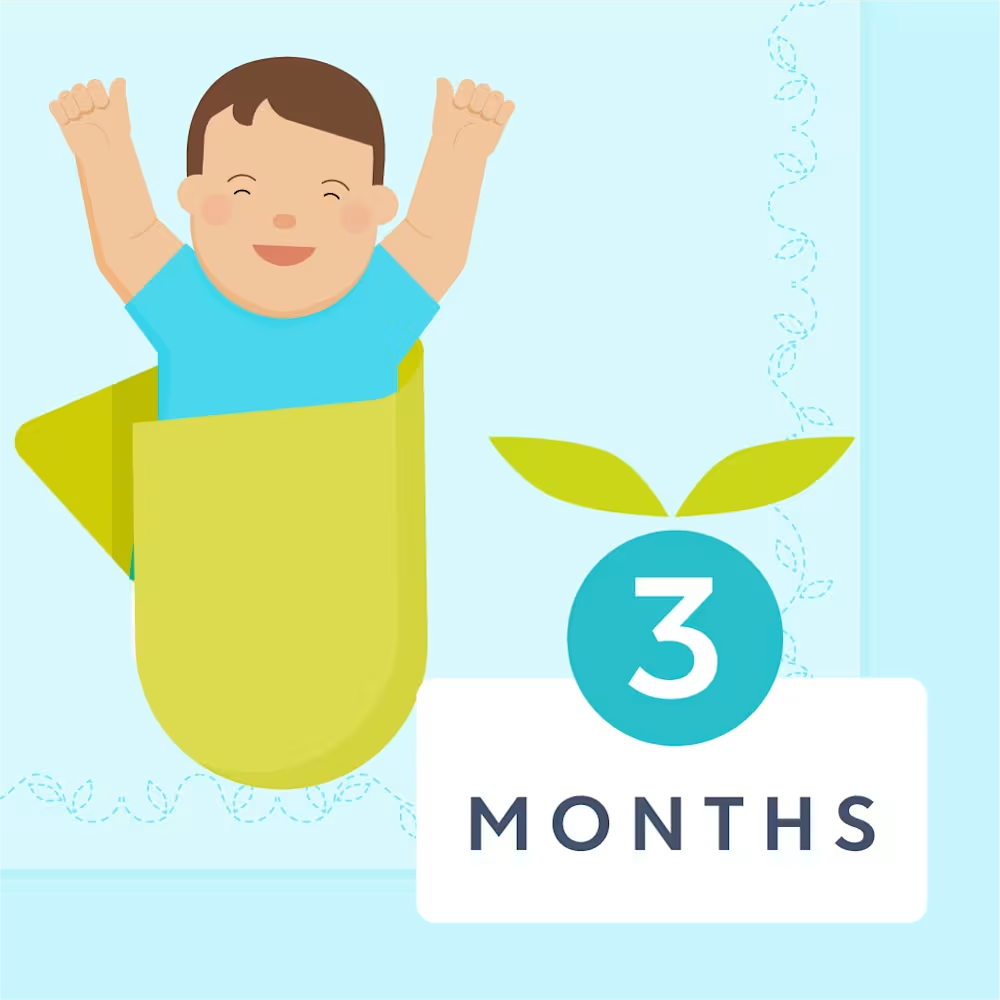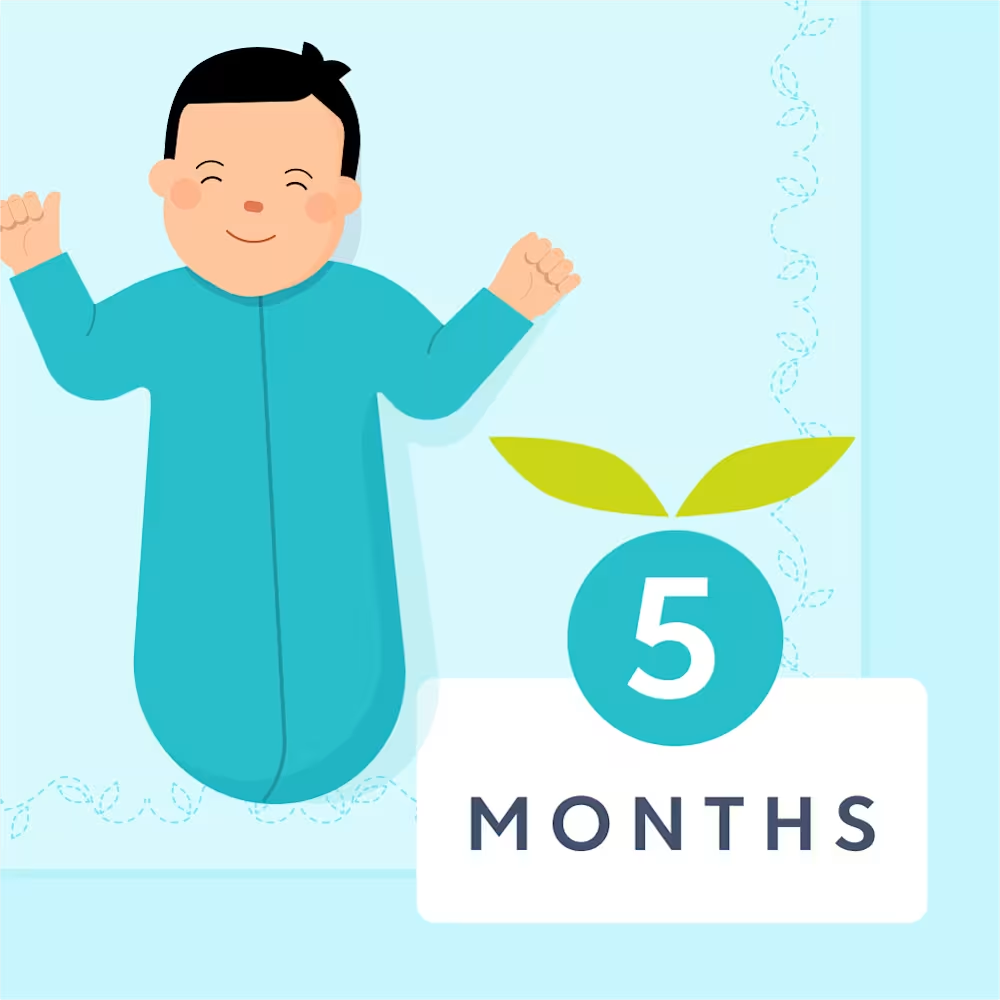4 month sleep regression: Why it happens and what you can do about it
Updated Dec 15, 2025

Around 3 to 4 months, babies go through a noticeable shift in their sleep habits. As your little one grows out of the newborn stage, their sleep architecture starts to mature, which leads to a change in their stages and cycles of sleep — and that’s when the changes often kick in.
If you’re suddenly seeing more frequent night wakings, shorter naps, fussiness, or your baby fighting sleep like never before, chances are this biological shift has occured. While this phase is commonly called the “4 month sleep regression” and feels like a gigantic step backward, try reframing it as a sign that your baby is growing and developing. It’s a normal (though exhausting) part of your child’s sleep development.
In this article, we’ll discuss the so-called “4 month sleep regression” and give you more info on healthy habits to start so your baby can get the sleep they need — and you can get some shuteye too.
Table of Contents
What is the 4 month sleep regression?
When babies are around 3 - 4 months old, their sleep patterns start to mature. Rather than continuing to, they have additional cycles of light sleep and deep sleep. This change can lead to new challenges because babies may fully wake between sleep cycles and need assistance getting back to sleep, so they call out for you. So it’s not uncommon for it to feel like your baby is suddenly not sleeping — with frequent night wakings, shorter naps, and difficulty falling or staying asleep in this phase.
Why do babies have a 4 month sleep regression?
It’s important to note that at this stage, changes in sleep are caused by a biological alteration in the way a child sleeps, rather than a regression caused by a temporary state. To put it simply, your baby may be waking more because they’re growing and developing — not because they’re going backward.
Despite this first big developmental growth spurt, don't pack up the pacifier and send them off to college just yet. The so-called sleep “regression” happens because your baby starts to wake fully between these cycles and needs help falling back to sleep.
Developmental changes at 3 - 4 months
At 3 - 4 months, your baby’s sleep patterns are starting to mature and that can actually make sleep a little trickier. As they begin to cycle through light and deep sleep more like adults, you might notice more frequent wake-ups and shorter naps.
In this new phase, babies briefly wake up after each sleep cycle (just like we do!). However, if they haven’t learned to fall asleep on their own yet, they’ll often need the same help they had at bedtime — like being rocked, fed, or held — to fall back asleep. And if that help isn’t there? They’ll probably let you know with some loud protest cries.
While exhausting, this is a normal part of your little one’s sleep development. Most babies this age still need some support to fall asleep and that’s OK. (We’ll walk you through gently building independent sleep skills when you’re ready.)
Signs of the 4 month sleep regression
Has your 4 month old’s sleep suddenly declined? Here are some common sleep regression signs. Your baby may experience one or all of them. Note: For premature babies, we go by their adjusted age for sleep development. So, the 4 month sleep regression signs may appear later for babies who were born early and that's normal.
Sudden worsening of night sleep
Increased crying or fussiness during sleep times and difficulty settling
Disrupted naps and less total daytime sleep
So, what happens during the 4 month sleep regression?
It’s those brief awake periods between sleep cycles that often derail your little one’s naps and nights. When a baby has a sleep onset association with feeding, rocking, holding (or something else that requires your help), they tend to . This tends to lead to more night wakings and short naps.
This is how it typically plays out:
Your baby falls asleep with your help, then is moved to the crib.
When they wake up between sleep cycles later and discover they’re no longer in your arms, this causes them to wake fully (rather than fall back to sleep on their own and shift onto the next sleep cycle).
Once wide awake, they often want help from you so they can get back to sleep. Another cuddle sounds way better than closing their eyes and doing it themselves, especially if they haven’t practiced the skill of falling asleep on their own yet.
Repeat through the night! Of course, this is exhausting.
Think of it this way — you fall asleep with a pillow, but when you wake up during the night, it’s mysteriously vanished. You’d want that pillow back and might have a hard time returning to sleep without it, right? However, if your pillow had remained under your head, you’d be able to just roll over and fall back to sleep.
How long does the 4 month sleep regression last?
It depends on what’s causing the sleep issues. Some sleep disruptions at this age are temporary and linked to normal development — like eating at night or short naps. In those cases, things may improve on their own within a few weeks.
But if your baby is struggling to fall asleep or stay asleep because they rely on something external (like being fed, rocked, or held to sleep) those sleep issues may continue until they learn to fall asleep independently. That’s because the ability to link sleep cycles and self-soothe is a skill that develops over time, often with some gentle guidance and consistency from caregivers.
So while some 3-month sleep issues pass quickly, others stick around longer if the underlying habits don’t shift. The good news? With the right support, most babies can build healthy sleep foundations over the coming months.
When does it start?
The “4 month sleep regression” typically begins between 3 - 4 months, when your baby’s sleep patterns go through a big developmental shift. What makes this regression different from others is that it’s driven by a permanent biological change — not by temporary factors like teething, travel, or growth spurts.
When does it end?
The 4 month sleep regression doesn't have a definitive "end.” However, babies tend to start sleeping better when they follow an age-appropriate, are developmentally able to link sleep cycles, and learn how to fall asleep independently.
With the right guidance, most babies can master falling asleep on their own by 5 - 6 months old, if not sooner.
Does the 4 month sleep regression affect naps?
It’s very common to see short naps (30 – 45 minutes) around this age. Babies often wake after one sleep cycle and may not yet have the ability to transition smoothly into the next without some help from a caregiver. While it can be frustrating, these catnaps are developmentally appropriate.
As your baby grows and begins learning to fall asleep more independently, naps often start to lengthen. By around 4 months, you may notice the first one or two naps of the day getting longer — especially if your little one is beginning to connect sleep cycles on their own. If your infant isn’t there yet, that’s OK too. We’ll provide tips below to get your started.
7 tips to navigate the 4 month old sleep regression
Tip #1: Practice having your baby fall asleep independently in their sleep space
Helping your baby learn to fall asleep on their own in their crib (or sleep space) at bedtime is one of the most effective ways to reduce frequent night wakings. When a baby can drift off without needing to be rocked or fed to sleep, they’re more likely to use those same skills to settle themselves back to sleep during those brief wake-ups — both overnight and during naps. The result? Longer stretches of sleep for them and you.
At around 4 months, it’s — or ramp up at your own pace if you’ve already been working on these skills. A good place to start might be having your baby fall asleep in their crib once a day and build from there. At this age, you’re laying the groundwork for independent sleep — some babies will adapt quickly, while others may need more time. Every baby is different, but encouraging these skills can lead to smoother nights in the future.
That said, it’s also completely OK if you’re not ready to work on independent sleep right now. It’s a personal choice, and only you can decide what’s right for your family.
Tip #2: Watch wake windows
It seems like babies should just fall asleep when they’re sleepy, right? Unfortunately, that’s not always the case. Babies fall asleep most easily when they’re tired, but not overtired. When infants stay awake too long, they tend to cry more at bedtime and have a harder time falling asleep and staying asleep.
Fortunately, giving your child the opportunity to sleep within the appropriate wake window can help them get the sleep they need. Most babies can comfortably stay awake for 1.5 - 2.5 hours at 4 months before their next snooze. If your little one has been awake for over 2.25 hours and still isn’t showing signs of being sleepy, go ahead and try for the nap. Sometimes physical sleepy cues can be fleeting and easy to miss. You can also skip the mental math and use the SweetSpot® sleep predictor in the Huckleberry app.
Tip #3: Establish a consistent bedtime routine
Setting up a consistent routine before naps and bedtime is a great way to help your baby understand that sleep is coming — even at this age. A calm, predictable wind-down helps relax little ones, making it easier to fall asleep.
A simple bedtime routine might include a feeding, a warm bath or quick wash-up, a fresh diaper and fresh pajamas, and a story or lullaby. When you do the same steps in the same order each time, your baby learns what to expect — and that sense of predictability can make the transition to sleep feel safe and soothing.
Tip #4: Keep the bedroom dark
Blackout curtains might be one of our favorite inventions. Since light exposure helps tell our internal clocks when to wake up, a really dark bedroom can mean longer naps and later wakeups, especially when it’s light outside.
After this biological shift occurs, sleep tends to be very light in the early morning hours, and children wake easily. If a baby sees light during this time period, it can signal their body to start waking early every morning. Darken the room to help prevent sunlight from turning your little angel into a little rooster, especially if you're dealing with a 4 month sleep regression.
A dark room can also help lengthen naps. Once their sleep has matured, babies tend to wake after one sleep cycle. If the room is too light, they can become distracted by their surroundings and fully wake up; a dark room can help encourage them to link their sleep cycles and fall back to sleep.
Tip #5: Don’t rush in
Babies can make a lot of noise in their sleep! If your child starts to stir in between sleep cycles, try giving them a little time before jumping in — many will drift back to sleep on their own if given the chance. Of course, it won’t work every time, but offering that brief pause can help build their ability to settle independently.
Tip #6: Evaluate hunger
If your baby suddenly starts waking frequently in the middle of the night, you may wonder whether they’re themselves back to sleep by sucking. To complicate matters, many babies go through a around this time and genuinely do need to eat more.
At 4 months old, many babies still need 1 - 3 feedings overnight. If they’re healthy, gaining weight steadily, and waking more often than that, it could be due to a sleep association — when babies regularly fall asleep while nursing or taking a bottle, they may look for that same comfort to fall back asleep during night wakings.
Consider whether you can offer more milk or formula during the day to help curb true hunger in the middle of the night. Consider offering longer or more frequent feeds during the day, cluster feeding before bedtime, or a before your bedtime.
Note: Speak with your pediatrician and/or lactation consultant to discuss your baby’s specific needs to ensure they’re getting the nutrition they need to grow and thrive.
Tip #7: Set realistic expectations
There are plenty of steps you can take to improve your baby's sleep around 3 - 4 months old. However, chances are sleep won’t be flawless at this age and there's no magical sleep regression solution. Not all babies can learn to consistently fall asleep on their own yet. This skill takes time, and not all babies are physiologically able to do so until 5 - 6 months of age.
Babies this age typically aren’t ready to sleep for 10 - 12 hours straight without some help. Likewise, you’ll likely continue to see some short naps for a while. While you may hear of some unicorn babies who sleep wonderfully at 3 - 4 months old, most of us will need to continue to give our babies the space to practice without expecting perfection.
If your goal is to work on getting your little one to fall asleep on their own in a crib, around 4 months you may consider trying methods like gradual withdrawal or pick-up/put-down method.
How much sleep does a 4 month old need?
, most babies need about 14.5 hours of total sleep over a 24-hour period. This usually breaks down to about 10 - 12 hours at night (broken up by feedings) and about 3.5 - 4.5 hours of sleep during the day, over 3 - 4 naps.
However, every baby is different! Some may need a little more or less sleep than this. We recommend paying attention to your little one’s mood and energy levels when determining if they’re getting the shuteye they need.
How can I tell if it's separation anxiety or 4 month sleep problems?
Many factors can contribute to sleep challenges at 4 months, so it’s not necessarily sleep problems OR separation anxiety. Around 4 months, your baby may start showing early signs of separation anxiety — — though it typically becomes more noticeable around 5 months. This is when babies begin recognizing the difference between their main caregivers and other adults.
At this age, early stranger anxiety may play a role in sleep issues — for example, your little one might be extra fussy at bedtime if someone else is putting them down, take shorter naps, or wake more frequently overnight. Still, there are plenty of other reasons sleep can be bumpy around 4 months (like that biological change in the way they sleep, as mentioned above). Since it’s hard to pinpoint one exact cause, focus on supporting your baby through it with consistent routines, comfort, and realistic expectations.
How can I tell if it's teething or 4 month sleep problems?
At 4 months, sleep can be unpredictable and it can be tricky to know exactly why your little one has suddenly decided they're allergic to sleep. Around this age, teething may overlap with the developmental shift in their sleep patterns (what's often called the "4-month sleep regression").
If your baby’s first tooth starts to erupt around 4 months — which happens! — you might notice swollen or tender gums, extra drooling, biting or chewing on hands, and occasional feeding refusal. Those signs point toward teething discomfort, which can temporarily disrupt sleep.
At the same time, your baby’s sleep architecture is maturing, meaning they’re cycling between light and deep sleep differently than before. This biological change can lead to more frequent night wakings or shorter naps, even without teething.
If both are happening at the same time, sleep may be rocky for a while. You might notice your baby waking after 10–20 minutes (mid-cycle) instead of after a full 50-minute sleep cycle. In this case, try to offer comfort, stick to consistent routines, and remember this phase is temporary.
Can you sleep train during the “4 month sleep regression”?
When it comes to , results can vary quite a bit from baby to baby. Some families are able to see drastic improvements quickly, while others will need to give it more time. If you choose to start sleep training at this stage, think of it as giving your little one the opportunity to practice falling asleep independently — though they might not fully get the hang of it just yet.
Starting sleep training now can help lay the foundation for healthy sleep habits, even if your baby is going through a sleep regression. However, keep in mind that progress may be slow or uneven at this age. Even if your little one starts to self-soothe at bedtime, they’ll probably still need some help during overnight wake-ups. It’s normal for babies at 4 months to learn to fall asleep independently at the start of the night but still need support during those lighter, more fragmented sleep cycles in the early morning hours.
The American Academy of Pediatrics (AAP) recommends placing your baby in their sleep space while they’re drowsy but still awake at 4 months. This helps them learn how to self-soothe, which can benefit both your baby and your sleep — fewer night wakings often mean more restful nights for the whole family. This is an early, gentle version of sleep training.
Can I let my 4 month old cry it out during a sleep regression?
While some parents may choose the total extinction (CIO) method to sleep train their 3 - 4 month old, we generally don’t recommend it. This method involves letting the baby cry themselves to sleep without offering comfort or reassurance. It can be particularly difficult for parents at this age, and younger babies may find it challenging to consistently fall asleep on their own. It’s common for infants at this age to need help from caregivers overnight, including feedings and comfort.
If a caregiver chooses to try this approach, we strongly suggest close monitoring. Use a video monitor and conduct regular safety checks at least once every hour to ensure the baby’s well-being.
What are self-care tips for tired parents?
Set boundaries: Now that you’re out of the fourth trimester, you may be wanting to do more — and that’s normal! However, it’s easy to overextend yourself, which can lead to more exhaustion. Try setting clear boundaries like saying no to extra tasks or social obligations when possible.
Get some fresh air: Even if it's just a short walk around the block, getting outside for fresh air and a change of scenery can do wonders for your mental health and mood. It’s a quick way to break up the monotony and feel refreshed. If you can’t get out of the house on your own, bring your infant too — at 4 months they’re becoming more alert and may love taking in the sights and sounds.
Practice mindful breathing: Taking a few minutes to breathe deeply or practice mindfulness can help calm your mind.
Should I let my baby sleep in my bed during a regression?
The AAP strongly advises against bed-sharing with your baby []. If you bring your baby into bed for snuggles or a feeding, they recommend placing your baby on their back in their own safe sleep space (such as a crib or bassinet) before you go to sleep. It’s also important to avoid falling asleep with your baby on other surfaces, like a couch or recliner, as the risk of infant death is significantly higher in these situations [].
When to talk to a doctor
Sleep regressions are a normal part of your child’s development and it’s common for sleep patterns to fluctuate as they grow. However, if you notice any concerning signs related to your child’s sleep, it’s a good idea to talk to their healthcare provider. Here are a few examples of when it might be time to reach out:
Sleep is bad and your baby seems uncharacteristically fussy or in pain: Something else may be at play — like an illness, reflux, or an ear infection — if your little one is inconsolable or much fussier than normal.
Feedings or weight gain decrease: If your baby is consistently missing feeds, has a noticeable drop in wet diapers, and/or isn’t gaining weight steadily, it’s a good time to talk to their doctor. If breastfeeding, it may also be beneficial to consult a lactation consultant.
Other symptoms are present: Fevers, rash, vomiting, and coughing aren’t associated with a sleep regression and you should reach out to your child’s doctor.
Your baby is sleeping too much: If can be a red flag if your infant is on the other end of the sleep spectrum and is unusually groggy or hard to wake.
You suspect something isn’t quite right: You know your baby best! If you feel like something is off, it’s usually best to check.
Takeaway
The 4 month sleep regression begins around 3 - 4 months of age. It happens when a baby begins to cycle between light sleep and deep sleep, like an adult, rather than the more constant state of newborn sleep.
This biological shift in the way your little one sleeps often leads to disrupted sleep — like more night wakings and short naps. This biological shift occurs in all babies, but not all will experience bumpy sleep when it happens.
A way to improve sleep is by giving your little one the opportunity to practice falling asleep independently — though they might not fully get the hang of it just yet. Starting a version of sleep training now can help lay the foundation for healthy sleep habits, even if your baby is going through a sleep regression.
4 month sleep regression FAQ
Share article:
Note: The content on this site is for informational purposes only and should not replace medical advice from your doctor, pediatrician, or medical professional. If you have questions or concerns, you should contact a medical professional.
1 Sources
Table of Contents
Share article:








